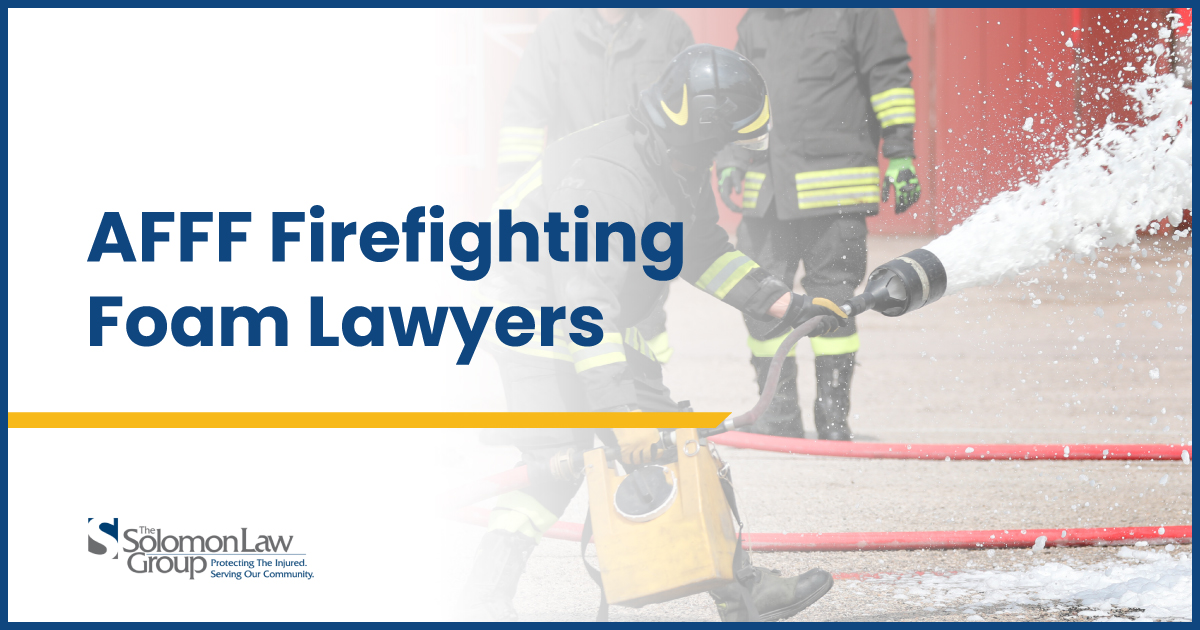There’s been a lot in the news recently about South Carolina AFFF firefighting foam lawsuits and related legal actions across the United States.
AFFF firefighting foam, also known as aqueous film-forming foam, has been a staple product of the firefighting industry since the 1960s. It’s primarily used to suffocate and extinguish flammable liquid fires, creating a chemical blanket that prevents oxygen from reaching the fuel source.
The use of AFFF has become common in a number of industries, especially the military, aviation, and oil refineries, as well as firefighting departments.
However, the chemicals used in AFFF, known as per- and polyfluoroalkyl substances (PFAS), have been linked to serious health concerns, including cancer.
These concerns have prompted recent legal action throughout the U.S., with a growing number of AFFF firefighting toxic foam lawsuits emerging, seeking compensation for victims who have been exposed to these chemicals and have developed cancer or other medical issues.
History of AFFF Products
Aqueous film-forming foam was invented by the U.S. Navy in partnership with the 3M company in 1966.
Initially developed to combat flammable liquid fires, the foam was so effective in firefighting operations that it saw widespread adoption by fire departments and military organizations.
Since then, AFFF products have been manufactured and marketed by a number of major corporations, many of whom have made significant contributions to the design, manufacturing, and distribution of AFFF for various applications and industries.
While the primary purpose of AFFF has always been firefighting, it’s been widely used for training exercises, commercial airport fire suppression systems, and industrial fire safety.
Harmful Effects of AFFF Firefighting Foam
AFFF’s harmful effects are mostly attributed to its per- and polyfluoroalkyl substances (PFAS). These substances are highly toxic, persistent, and bioaccumulative, a combination that makes them especially dangerous.
PFAS have been associated with a variety of health issues. These include:
- Cancer
- Hormone disruption
- Immune system dysfunction
- Autism
- Fetal developmental problems
Because PFAS chemicals like those in AFFF aren’t easily broken down in the natural environment, they tend to accumulate in water sources and run-off zones, causing long-term contamination in these areas.
Some chemical companies, including 3M (one of the pioneers of AFFF), are now facing personal injury claims related to their firefighting foam.
It’s crucial, given these potential risks of AFFF use, that we examine the actions of these manufacturers and hold them responsible for addressing the harm and damages caused by their products.
It has also been suggested that certain manufacturers have ignored the harmful effects of AFFF foam and continue to market these products for sale without supplying adequate warning or taking safety measures to mitigate those risks.
The number of personal injury claims and the mounting evidence regarding the harmful effects of AFFF products on health and the environment is growing exponentially. These concerns raise serious questions about the ethical and legal obligations that these types of companies are held to, as well as the need for greater accountability.
Widespread concerns about the ethical responsibility of manufacturers show there is clearly a need for greater transparency and accountability in the development, sale, and use of AFFF products.
Manufacturers must prioritize the safety of their consumers and the environment, if not by their own ethical code, then by legal compulsion and consequences.
Links Between AFFF Firefighting Foam and Cancer
There is strong evidence linking aqueous film-forming foam exposure to various types of cancer.
Elevated concentrations of linear PFOS, a PFAS chemical found in AFFF, have been associated with an increased risk of thyroid cancer. The thyroid gland, located at the base of the neck, is responsible for producing hormones that regulate metabolism.
Studies have shown that individuals with elevated levels of PFOS in their blood have a higher risk of developing thyroid cancer.
There’s also significant evidence linking AFFF exposure to testicular cancer.
Research has shown that firefighters and military personnel, who are often exposed to AFFF in the line of duty, have higher rates of testicular cancer compared to those in the general population.
Other types of cancer have also been associated with AFFF exposure as well, including increased risk of kidney, prostate, and pancreatic cancer. These findings suggest that the chemicals in AFFF have the potential to cause a wide range of cancers.
The National Firefighter Registry, established by the Centers for Disease Control and Prevention (CDC) and the National Institute for Occupational Safety and Health (NIOSH), aims to track and analyze cancer rates among firefighters, including those exposed to AFFF.
The goal of this registry is to provide valuable data on the long-term health effects of AFFF exposure, as well as help inform future prevention and safety measures. Studying the link between AFFF exposure and cancer allows researchers to better understand risk factors and to develop strategies that will protect firefighters and other individuals who are in danger of exposure.
It’s crucial for anyone who’s been exposed to AFFF, especially firefighters and members of the military, to know the potential health risks and seek any necessary medical attention and legal recourse to protect themselves and their future.
Dangers To Water Providers and the Environment
Another significant concern associated with AFFF is its potential to contaminate water sources and pose risks to water providers and the environment.
The PFAS chemicals present in this toxic foam can leach into the groundwater and contaminate drinking sources, posing a significant threat to human health.
One example of the environmental dangers posed by AFFF is the contamination of groundwater near military bases and airports. In several instances, the use of AFFF during firefighting training exercises resulted in the release of PFAS chemicals, often referred to as “forever chemicals,” into the environment, leading to long-term contamination of water sources.
These contaminated water supplies not only affect local communities but, depending on the level of the contamination and the flow of groundwater, can also expand to contaminate much larger areas.
The potential risks to water providers and the environment highlight the urgent need for preventive measures and responsible actions by manufacturers. We must prioritize the development and use of safer alternatives to AFFF to minimize the environmental impact and protect water sources from contamination.
Legal Processes and Personal Injury Claims
In response to the harm caused by AFFF foam products, legal processes have been initiated to hold manufacturers accountable. Lawsuits and personal injury claims are being pursued by individuals and communities affected by the health and environmental consequences of AFFF exposure.
Manufacturers of aqueous film-forming foam are accused of knowing about the harmful effects of their products but failing to provide adequate warnings or take appropriate action to protect the public.
These lawsuits aim to hold the manufacturers accountable and seek compensation for medical expenses, lost wages, and pain and suffering, among other damages.
Tyco, 3M, and Dupont are among the manufacturers facing personal injury claims related to AFFF firefighting foam.
The legal processes surrounding AFFF litigation are complex and involve multiple parties, including plaintiffs, defendants, and legal experts. Still, these personal injury claims and lawsuits are important to pursue, as they are a means for affected individuals and communities to seek justice and hold manufacturers accountable for the harm caused by their AFFF products.
These legal processes also raise important questions about the regulation and oversight of firefighting foam products and the role of government agencies in ensuring public safety.
Parties Involved in AFFF Firefighting Foam Lawsuits
Lawyers across the country are representing individuals filing AFFF firefighting foam lawsuits.
These lawsuits aim to hold the manufacturers and distributors of AFFF products accountable for any harm caused by their products. The parties involved include the plaintiffs, who have been exposed to AFFF and developed cancer, and the defendants, who are the manufacturers and distributors of AFFF products.
The plaintiffs’ legal representation consists of experienced attorneys who specialize in personal injury and product liability cases. These attorneys work to gather evidence, build a strong case, and seek compensation for their clients.
The defendants, on the other hand, are represented by their own legal teams, who defend their clients against the allegations of negligence and seek to minimize their liability.
Court-appointed mediators play a crucial role in settlement talks as well, helping with negotiations between the parties and assisting them in reaching a resolution. The mediator is a neutral third party who’s there to help find common ground and a fair settlement.
Mediators are especially important in complex cases like AFFF lawsuits, where multiple plaintiffs and defendants are involved, and the stakes are high.
Through the legal process, individuals who have been exposed to AFFF and developed cancer can seek compensation for their injuries and hold the responsible parties liable for their actions.
Resolutions, Bans, Settlements, and Lawsuits
As the harmful effects of AFFF have become more widely recognized, various resolutions, bans, settlements, and lawsuits have emerged to address the issue, provide remedies and preventive measures, and to mitigate the ongoing harm caused by AFFF products.
For example, cases related to AFFF firefighting foam are pending in the South Carolina court, where affected individuals and communities are seeking compensation for health issues and environmental contamination caused by these toxic foam products.
Additionally, there have been bans on PFAS-containing firefighting foams in Colorado, highlighting the recognition of the potential risks associated with these products. Settlements have also been reached in some cases, where manufacturers have agreed to provide financial compensation to affected individuals and implement measures to prevent further harm.
These resolutions, bans, settlements, and lawsuits reflect the growing awareness of the harmful effects of AFFF firefighting foam and the need for action to protect public health and the environment.
Holding Manufacturers Accountable for Harmful AFFF Products
It’s crucial to hold manufacturers accountable for the harm caused by AFFF products.
These ongoing legal processes, including lawsuits and personal injury claims, play a vital role in seeking justice for those affected by the harmful effects of AFFF firefighting foam. Continued attention and efforts are equally necessary to address the issues related to AFFF and ensure the future safety of both individuals and the environment.
Manufacturers have a responsibility to prioritize safety and take action in light of the evidence of harm caused by their products. Additionally, government agencies play a crucial role in regulating and overseeing the use of firefighting foams to protect public health and the environment.
Moving forward, it’s essential to continue research on safer alternatives to AFFF-containing products and invest in technologies that can effectively suppress fires without the harmful effects of PFAS chemicals.
By working together, manufacturers, regulators, and communities can strive to prevent further harm and ensure a safer future for ourselves, our families, and our environment.
If you, or someone you know, has been exposed to AFFF products resulting in illness, or you have any questions about South Carolina AFFF firefighting foam lawsuits, please contact us today to discuss your legal rights.












